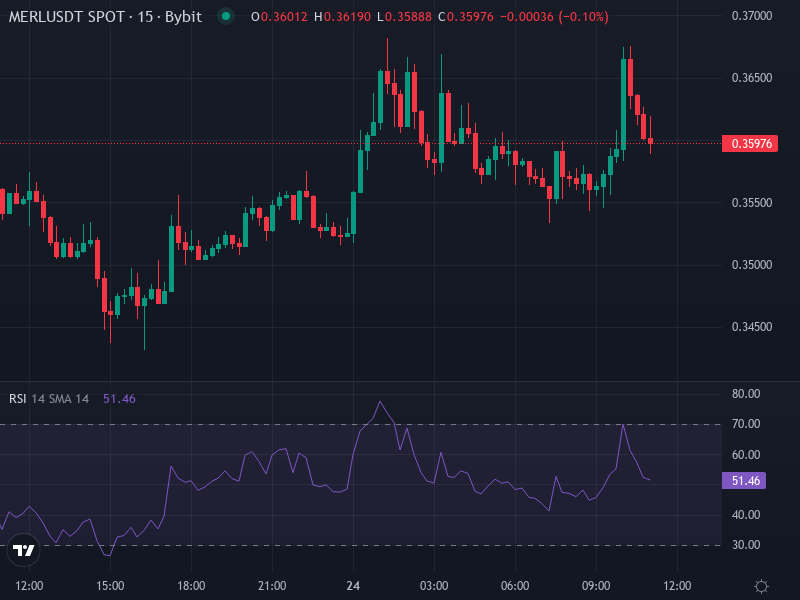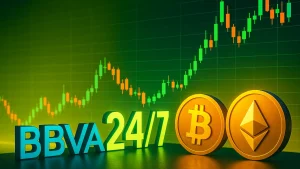Current Market Context & Key Catalysts
Merlin Chain (MERL/USDT) is currently trading at around $0.3592, showing a small uptick of about 1.15% in the last 24 hours. What’s got traders talking right now is the network upgrade that rolled out on November 7, which brought some pretty significant ZK-Rollup scalability improvements. Plus, deposits and withdrawals are back up and running on big platforms like Bithumb and Bybit, which has definitely helped boost confidence in MERL’s ecosystem.
When it comes to overall market sentiment though, people are being pretty careful. There’s a lot of fear floating around the crypto space right now – the Fear & Greed Index is actually sitting in “extreme fear” territory. One interesting development is that MAGBX recently listed MERL/USDT, suggesting there might be growing interest from retail traders, particularly in Asian markets.
From a technical perspective, MERL has found some solid ground near $0.359, which lines up nicely with the 61.8% Fibonacci retracement level and sits right around its 30-day simple moving average of about $0.349. Momentum indicators aren’t really screaming anything dramatic right now – the RSI is hovering around 50-55, so it’s neither overbought nor oversold. That said, the MACD patterns are starting to hint at a possible bullish divergence forming. Looking up, there’s resistance hanging around $0.433, with a more ambitious target sitting near $0.478, which is where MERL peaked back in June 2025.

Short to Mid-Term Technical Projections
Based on what we’re seeing in the charts and looking at historical volatility patterns, there’s a real possibility MERL could pull back toward the $0.270–$0.300 range over the next couple to four weeks, especially if the broader altcoin market takes a hit. Some prediction models are actually calling for drops somewhere in the ballpark of 20% to 25% by late December 2025. The 50-day SMA is sitting just under the current price right now (around $0.347-$0.350) and will probably act as the first line of defense. If it breaks below that level, we could be looking at a slide toward the 200-day SMA near $0.180–$0.200 in a really bearish scenario.
On the flip side, if MERL can hold the line above $0.359 and we start seeing some decent buying volume come in, there’s definitely a scenario where price could push toward $0.430–$0.480 in that same timeframe. That kind of move would probably need some serious institutional money flowing in or some positive news – maybe new network partnerships or bigger DeFi integrations.
Indicators Snapshot
• RSI (14-day): Pretty neutral right now at around 50-55, nothing extreme either way.
• MACD: Starting to look like a bullish crossover might be forming, but it really needs more volume to confirm.
• Moving Averages: The 50-day SMA is just below where we’re trading now, providing short-term support; the 200-day SMA is way lower down, which tells us the long-term trend has been climbing but won’t help much if things drop fast.
• Fibonacci retracements: Main support sitting at the 61.8% level around $0.359, with resistance zones at about 23.6%, and the major high up at roughly $0.478.
Long-Term Outlook & Risk Considerations
Looking further out toward mid-2026 and beyond, forecasts are all over the map. Some models are optimistic, projecting MERL could climb to somewhere between $0.50 and $1.00 if the ecosystem really takes off – especially if MERL gets more traction as a Bitcoin Layer-2 solution for DeFi and other applications. Other forecasts are way more conservative, suggesting prices might just hang out in the $0.30–$0.60 range unless something major changes or we get some serious macro tailwinds.
As for risks, there are a few big ones to watch. Altcoin selloffs triggered by Bitcoin corrections could drag MERL down, the network upgrades might not deliver the real-world performance everyone’s hoping for, regulatory issues could pop up (especially for Layer-2 or cross-chain tokens), and liquidity problems like limited exchange listings could make it harder for people to buy and sell. On the positive side, things could really take off if we see improving Total Value Locked numbers, more developers building on the platform, new bridge integrations getting launched, or broader market shifts toward actual on-chain utility rather than just speculation.




